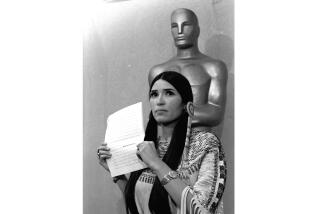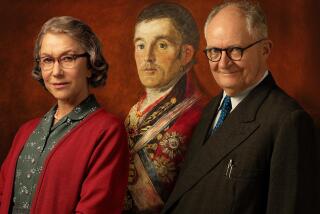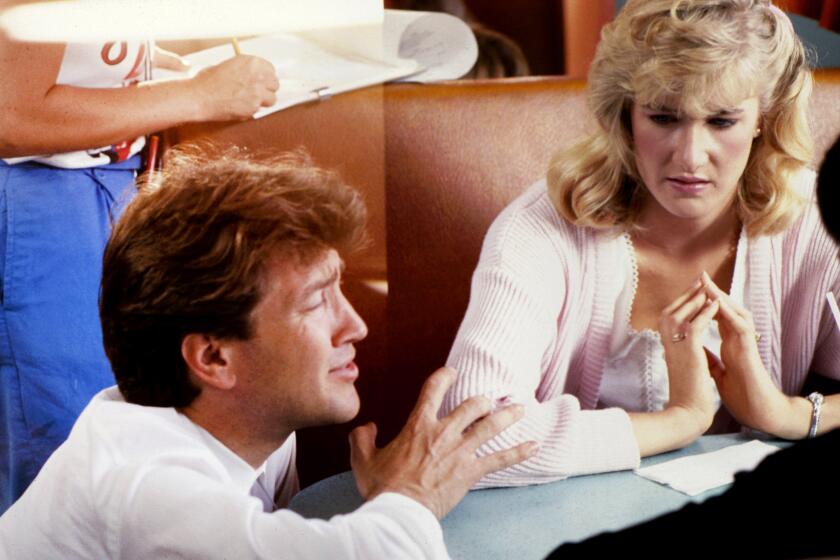A Noble Tribute to the Duke : Movies: Lone Pine--one of John Wayne’s ‘favorite places of all time,’ according to his widow, Pilar--honors the actor at annual film festival.
- Share via
LONE PINE — It’s vintage John Wayne.
There he is, astride his horse at 71, and behind him loom the rocky Alabama Hills on the eastern slope of the Sierra Nevada, one of Hollywood’s favorite movie locations since the 1920s.
“Beautiful country,” he says in his gravelly voice as he rides toward the camera in his final Great Western Savings commercial, filmed in 1978. “You know, I rode out here about 50 years ago on a little dun horse and started a film career in a picture called ‘The Big Trail.’ ”
Actually, “The Big Trail”--the 1930 movie in which a 22-year-old Wayne had his first starring role after a handful of bit parts--was filmed in Yuma, Ariz.; St. George, Utah; Moiese, Mont.; Sequoia National Park and Sacramento.
But what the heck.
As the frontier newspaper editor says in another John Wayne Western, “The Man Who Shot Liberty Valance”:
“This is the West, sir. When the legend becomes fact, print the legend.”
Although Wayne may have been taking dramatic license in his Great Western commercial, there is no denying that the spectacular rock outcroppings of these hills played a role in his 60-year movie career--from “Blue Steel,” a low-budget Monogram Western from 1934, to that Great Western commercial, his last professional appearance on camera, filmed less than a year before he died of cancer.
And it is here, in this tiny town in the shadow of Mt. Whitney, that Wayne was paid tribute last weekend at the fourth annual Lone Pine Film Festival.
Shop windows on Main Street (Highway 395) were plastered for the occasion with John Wayne movie stills. Vintage Wayne movies were being shown in the high school auditorium. And Sunday morning, the VFW post was offering--what else?--”The Duke’s Breakfast”: “True Grit” pancakes, “Yellow Ribbon” scrambled eggs, “Green Beret” sausages.
Joining hundreds of fans during the weekend was the Duke’s widow, Pilar Wayne, who drove up from Newport Beach to share her memories with a few of his old movie-making buddies including his “She Wore a Yellow Ribbon” co-stars John Agar and Harry Carey Jr.
“He would have been very proud,” said Pilar Wayne, who served as grand marshal of the parade through town on Sunday. “Lone Pine was one of his favorite places of all time.”
Seven of his movies were filmed here, including “Westward Ho” “King of the Pecos,” “The Oregon Trail” and “North to Alaska.” But they weren’t all Westerns. In “I Cover the War” (1937), he played an ace newsreel cameraman with the Alabama Hills filling in for Samari, “a desert hotbed of tribal unrest.” And in the 1947 “Tycoon”--which was shown in the high school auditorium Saturday night--he played a construction engineer building a railroad through the Andes.
People could take bus tours through the hills where markers pinpoint many of the exact location sites. Still embedded in the boulders at the “Tycoon” site are several eight-inch “O” rings that held guy wires to support a mountain facade and railroad tunnel built by RKO. And the video monitor showing the Great Western commercial was on the same spot where he rode up to the camera.
“We’re old-time Western movie fans, but John Wayne is obviously one of our favorites,” said 58-year-old John Perry of Newport Beach, waiting to board a tour bus with his wife, Melody. “For me, it’s his Americanism--American flag, apple pie, human rights, et cetera, et cetera.”
“He was a really good guy,” added Melody, 46, “someone you could look up to. We need more good role models like the Duke.”
To commemorate the old filmmaking days in Lone Pine, Pilar Wayne dedicated a bronze plaque Sunday. It will adorn the Dow Villa Motel, which was the home away from home not only for the Duke but for Hoppy, Roy, Gene and a slew of other Western movie heroes.
Originally called the Dow Hotel, it was built in 1923 by the owner of the town’s lumberyard to accommodate the growing numbers of movie companies coming regularly to Lone Pine. It was a time when, as one vintage actress has recalled, “the tubs had legs and the toilets had pull-chains.” Motel rooms were added to the hotel in the ‘50s; it was in motel room 20, as the plaque notes, that John Wayne stayed in August of 1978 while making his Great Western commercial.
Many of the celebrity guests last weekend fondly recalled the old hotel. Gene Autry sidekick Pat Buttram joked about how hard it was “crawling up the stairs of the Dow” after a night of revelry.
Buttram, who feels “movies went down the day they made Dustin Hoffman a leading man,” was in good form during a panel discussion Saturday, cracking that he heard that Gene Autry called Roy Rogers “to ask how much it would cost to stuff a baseball team.”
Joining Buttram on the panel to discuss their filmmaking days in Lone Pine were Carey, Agar, Dick Jones (TV’s “Buffalo Bill Jr.”), Jan Merlin (TV’s “Tom Corbett, Space Cadet,” who menaced Audie Murphy in “Hell Bent for Leather”), rodeo legend Monte Montana, Peggy Stewart (“The Queen of Republic Westerns”), Western movie badman Pierce Lyden of Orange, movie stuntman Loren Janes and actor John Mitchum, who wrote the words for an album Wayne recorded in 1973, “America: Why I Love Her.”
Pilar Wayne, a former actress, remembered first meeting the Duke--”the most handsome man I ever met in my life”--in 1952 when he visited the jungle location of a film she was making in her native Peru.
She said she had no idea who the tall man in the cowboy hat was; it usually took 10 years for an American movie to be released in Peru and she hadn’t seen many Westerns. And, she recalled, once she did know who he was, she told him he was “wonderful in ‘For Whom the Bell Tolls,’ ” to which Wayne laughingly replied: “You’re thinking of Gary Cooper!”
At the time, John Wayne was the top box office star in the world. Still, “he gave you more in a scene than anyone I ever worked with,” Carey, now 72, recalled during an interview. “Just in rehearsal he’d raise your whole metabolism by 20 notches. He had tremendous energy in a scene.”
Carey added that if Wayne wasn’t working for veteran directors John Ford or Howard Hawkes, “he could get kind of ornery on a set”--though not as ornery as Ford himself could get.
Carey said that when he was working on “Three Godfathers,” his first film with Ford and Wayne, he caught so much “hell” from the director that “if it hadn’t been for Duke I don’t think I’d have finished it.”
More to Read
Only good movies
Get the Indie Focus newsletter, Mark Olsen's weekly guide to the world of cinema.
You may occasionally receive promotional content from the Los Angeles Times.










